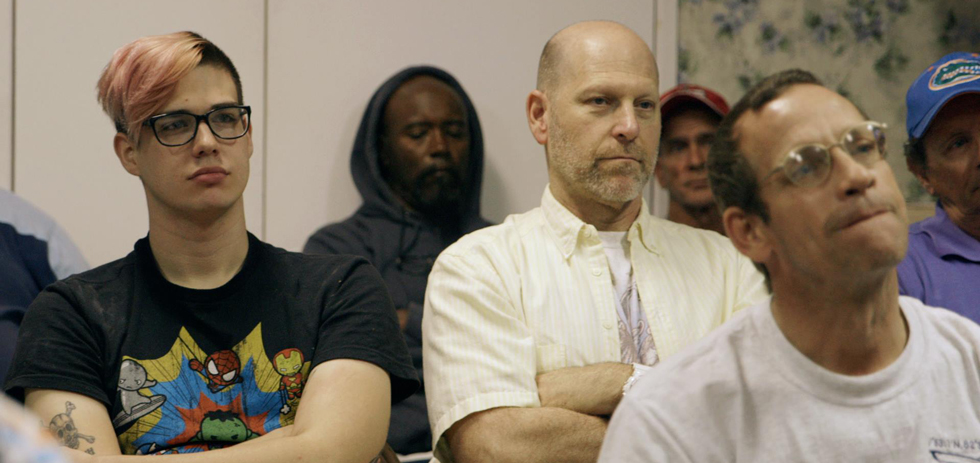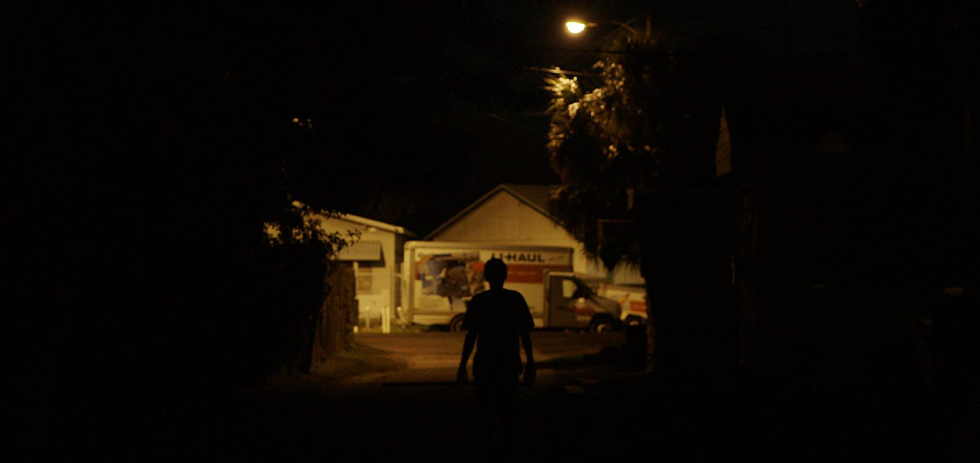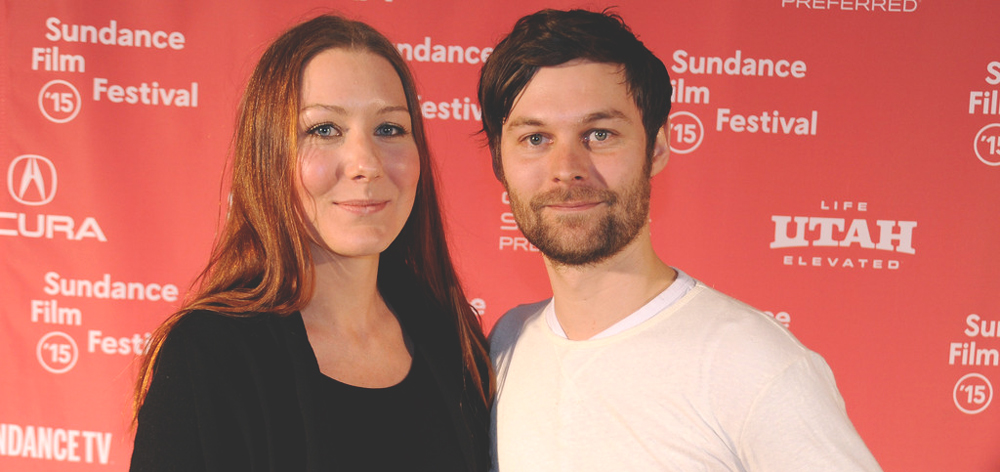Fresh from its win at Sundance for the the Special Jury Prize for Impact, Pervert Park screened last week at HotDocs for its Canadian premiere. The masterfully constructed and confronting documentary sheds light on the Florida Justice Transitions Park, a trailer park community and rehabilitation program for released sex offenders. The emotionally layered film works not to transgress or revel in the taboo, preferring instead to uncover the multi-faceted conditions of trauma, cycles of abuse and the potential journey towards healing. Inspiring extreme repulsion and a complicated empathy, Pervert Park is a strenuous yet important watch.
We sat down with co-directors Frida and Lasse Barkfors to chat about the making of this challenging new documentary.
How did you come to discover this park?
Frida Barkfors: So we read this newspaper article about five years ago and it described this parallel society where the sex offenders had to create jobs for themselves because they couldn’t find jobs outside of the park. So we went there to make what we thought was going to be an anthropological film about this, as I said, parallel society. Then when we got there we met with them and just started talking to them, in order to gain their trust and permission to film. And then we realized what we thought, or what a sex offender was portrayed as in the mainstream media, was not what reality looked like, so we decided we had to make a film about that.
How did you build relationships with this community? The interviewees share a lot in the film and allow themselves to be incredibly exposed, yet at the same time we see that they are quite suspicious and hostile to outsiders.
FB: Yeah, I think for us it was very much about showing them that we didn’t have a hidden agenda. Time was our friend in doing so, because we couldn’t finance the project so we worked on it for a very long time, and by that they could tell that we actually, we meant it. We weren’t just there quick to make some sensationalist type of film. We actually wanted to make a film about them. And I think another thing is that we just listened; we didn’t ask questions that were directing them in a certain way but just said, you know, “tell your story and we will see where it takes us.”
I’d say the film is sensitive without necessarily being sympathetic. How did you navigate the temptation to take a moral stance with such a loaded subject like this?
Lasse Barkfors: We didn’t want to go in a direction where we would take a stand, we would rather have the audience take a stand of their own, letting them [the subjects] tell their stories in their own perspective. It is really about balance in the editing process. It’s more that we wanted to present what we met in the park as close to reality as we could, so that people who watch the film would go through the same emotions that we did. I mean we cried with them, laughed, and we felt angry at them, all these emotions.
FB: And we cared for them a lot. We felt a lot of empathy for them. I mean really that was the key, trying to make an honest film and then it kind of gave [us that] itself. We wanted to make a film that was humanizing these people rather than making an activist film against the system because we felt that if we do that we’re not going to change anyone, you know? We are not going to make a film for someone who already has an opinion about this system being wrong. It was important for us to spark a debate on: “okay, so this exists, can we do anything? Can we handle the problem in a better way to break the cycle or is the way that we treat it today helping?”
LB: And we didn’t want to be suspicious but we wanted to check all the facts so they didn’t lie or minimize. So every time we made an interview we would ask their therapist or the CEO of the park who knew their files whether they were telling the truth or not.

Could you talk about your process of co-directing the film? Were there any points where you disagreed regarding the position you wanted to take?
FB: No, like we are married – it’s funny so we talked about it and we’ve been working on this film for five years and I think we had like two small arguments throughout those years, work related of course cause, I mean, you know. But working together is super easy. We agree, which was fantastic. That’s also why we are making the next film together. It’s not like we always have the same opinion but we would always agree on who had the best opinion. So if someone had an idea it was like “oh yeah well you’re right”, “actually yeah I can see that.”
I thought the lack of non-diegetic sound was a very interesting choice, it felt as if you were trying to resist creating an overtly dramatic mood.
LB: Yes and also not to…we trust the audience, so we didn’t want to. For us it would be fake to put something that would empower an emotion. It is so much in the film that it is not needed in the first place. And then if you have lyrics they will have some kind of meaning and it’s really difficult to put something in that you would feel would have a meaning. Because you try to grab all the time “what do the filmmakers think about this?’” and we don’t tell you. Because that’s our position, it’s that when the film’s over you should take the stand about what you think. And for us that’s a way of keeping the film alive afterwards for the audience, because they’re not told what the answer is.
FB: And I think that also goes with many of the things that they say gives you mixed emotions. I mean when Tracey tells her story we can be appalled by what she did but we can also care for her at the same time. If we had put music on that you would only be entitled to one feeling. And what’s important for us is to really show that you can have many emotions at the same time.
I really loved that after delving into each character’s story there was this almost painfully monotonous return to the empty shots of the park grounds. I imagine it would be very challenging to make a film that is as aesthetically interesting as this when it’s largely confined to talking heads and the park environment. Was it a conscious decision to have the spatial reality of park feature as almost a main character?
LB: Yes absolutely. That was kind of the idea for a long time that the park should be the main character. But we were trying to get as many moods of the park as we possibly could for the short time we were there. So if it rained we speeded out to have rainy pictures, so we could use it in the moods along the way.
FB: Sometimes, and sometimes of course it was for contrast. You know going into sunshine after a sad story, so it was a bit intuitive in that sense.
LB: Yes. In the edit we were trying to go from, you know, tell the story that is horrifying and then at the same time you see Tracey laugh in the bible class, just to get contrasts.
FB: Yes, to get mixed emotions. Or double emotions.
Could you reflect a little bit on the decision to contain the film within the world of the park, with a tight focus on the sex offenders themselves, rather than film the surrounding civilian community or the victims?
FB: Yeah I mean we decided early on that this is not a journalistic film so we are not going to include any victims. And also due to a formal decision to stay within the park. But I think one of the big reasons for doing so is because we wanted to give a voice to some people that are normally not heard and we felt that there are so many good documentaries and things written about victims and we didn’t feel that we could add that much to that story. But it really felt that we could actually add something to this side of the story, so we wanted to focus on that.
LB: There’s also the point in the film about the offenders being victims themselves and in order to keep that present, really present, in the film it was kind of important not to go too far out of it.
FB: Yeah because then there would be a divide, the victims and the real victims.

Did the film tonally evolve much in the editing phase or did you go into post production with a clear idea of the film you had?
LB: So because we couldn’t afford more than 23 days of shooting we had to be very tight, so we knew exactly what we were doing in terms of where the film started and where it ended, and then we didn’t know where exactly where the stories would lay out in between. But we had a good idea about how the film would be.
The film definitely has a fly on the wall experience for the viewer. Are you saying you had an already formulated arc in mind?
FB: Not in the sense that it was constructed or that we set it up, we did observe in that sense.
LB: It’s more like we knew that we were going to start at night with Bill the main character doing his rounds. That kind of image. Then when we did the interviews we knew we’ve had the start of the film when he talks about his childhood. And then we knew the barbeque scene, [we thought] this is obviously the end.
FB: Yeah because they are all together. And we knew that Bill was going to be a thread throughout the film so we made sure we had lots of material of him walking throughout the park in different times of the day and different weathers and things like that. And with the other characters we focused on doing at least two interviews with them and having some everyday life shots.
LB: What I mean by the ‘in-between stuff’ is really the balance of the film. Because we wanted it to be surprising all the time. That was how to keep the audience. When you think you know what this is there will come another point that gets things confusing again, so you are always on guard.
Thank you so much for sitting down with us.
FB: Thank you.
LB: Thanks.
